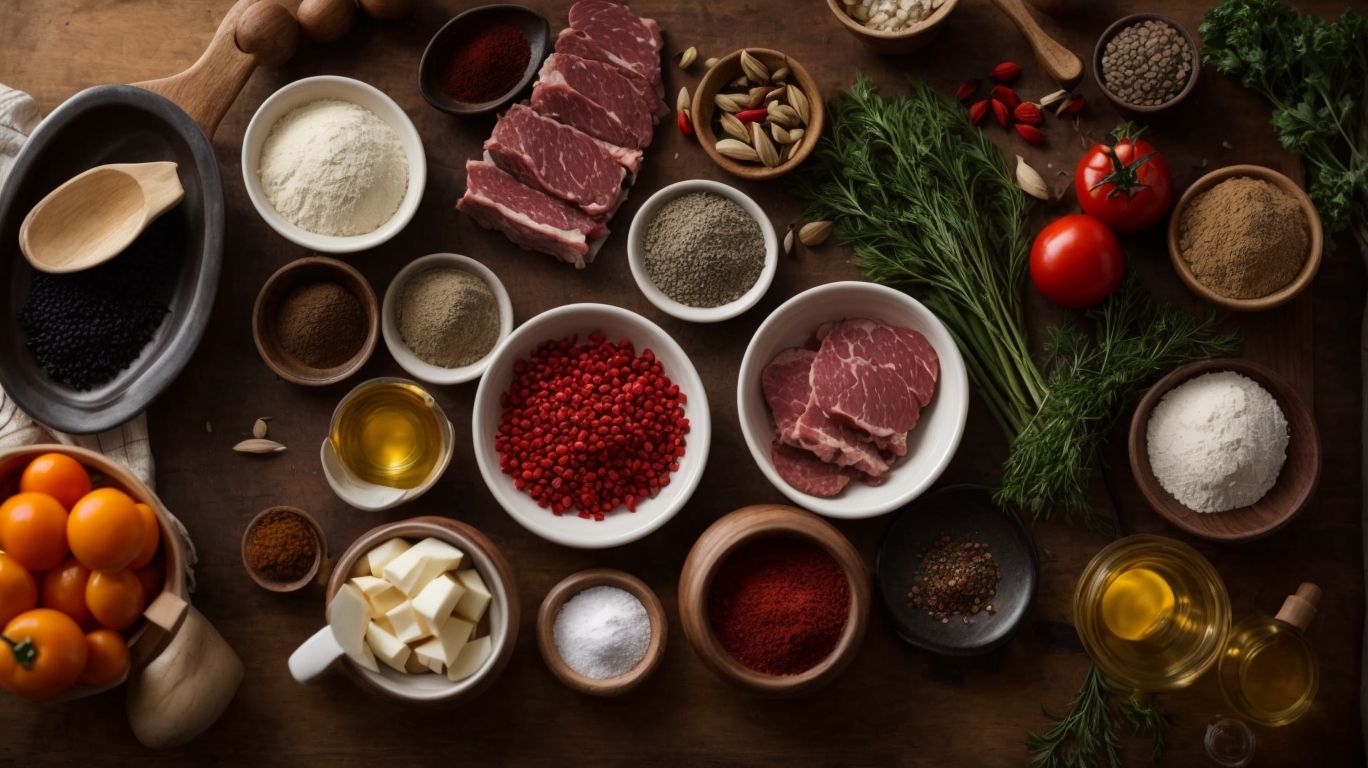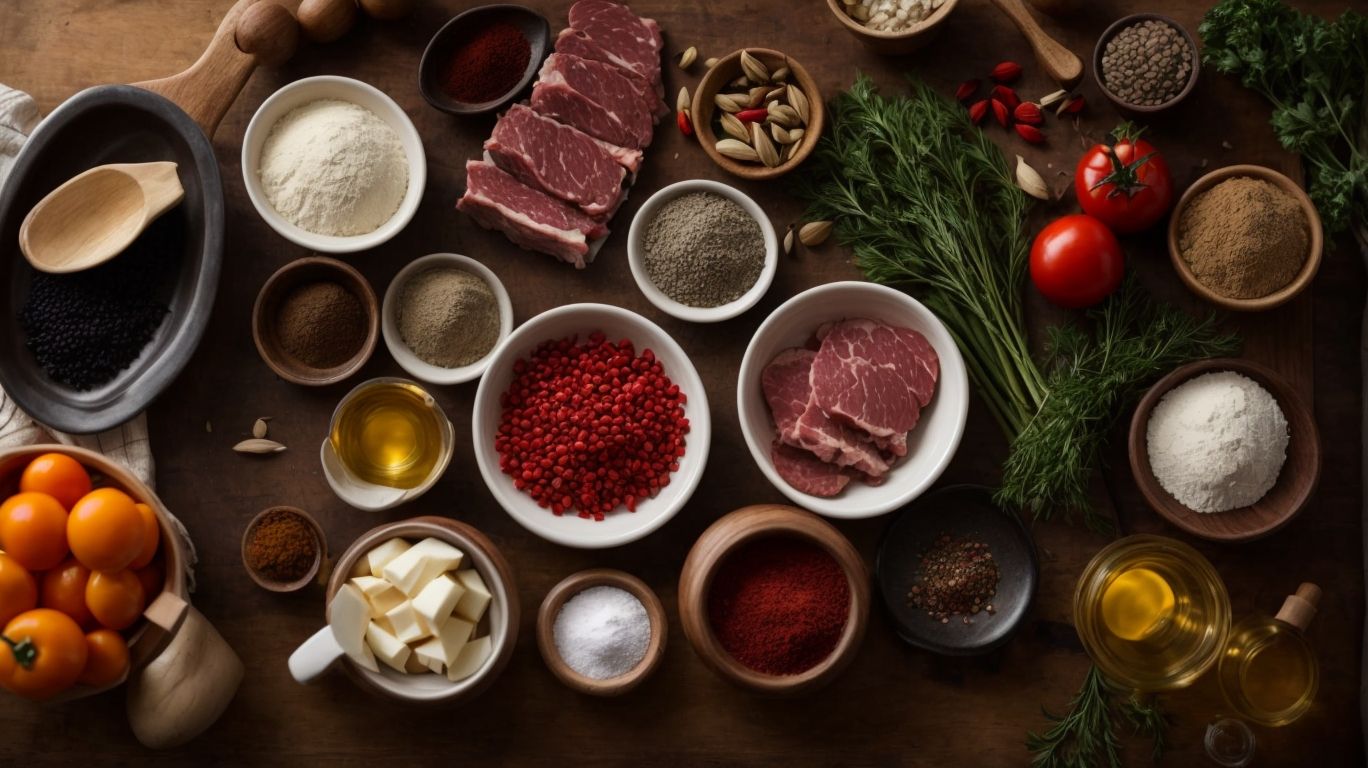How to Cook Nsala Soup Without Yam?
Are you a fan of traditional African cuisine?
Nsala Soup, also known as “White Soup”, is a Nigerian delicacy bursting with flavor.
We will explore what Nsala Soup is, its traditional ingredients, and why you might want to try cooking it without yam.
Find out how to make Nsala Soup without yam, including ingredient substitutes and step-by-step instructions.
Stay tuned for tips and tricks to help you create the perfect Nsala Soup without yam!
Key Takeaways:
About Nsala Soup
Learn all about the delicious Ofe Nsala soup, a traditional Nigerian delicacy that has captured the hearts of food enthusiasts worldwide.
Ofe Nsala soup, also known as White Soup, holds a significant place in Nigerian culinary heritage. Originating from the southeastern part of the country, this flavorful dish is often prepared during special occasions and celebrations, symbolizing unity and community bonding through shared meals.
The unique blend of spices, herbs, and protein-rich ingredients like fish or meat gives Ofe Nsala its distinctive taste. It is traditionally cooked with yam or cocoyam to create a thick, creamy texture that is a delight for the taste buds.
On platforms like the African Food Network, Ofe Nsala soup has gained popularity, showcasing the richness of African cuisine and its diverse flavors to a global audience.
What Is Nsala Soup?
Nsala Soup, also known as ‘white soup’, is a rich and flavorful Nigerian dish that combines aromatic spices and a creamy texture.
This traditional soup is highly regarded for its unique blend of flavors that come from the generous use of utazi leaves, bold seasoning, and fresh fish. The preparation process involves pounding the spices and herbs to extract their flavors, creating a base that is simmered with palm nut extract and chunks of meat or fish.
One of the key ingredients that sets Nsala Soup apart is the use of yam paste, which thickens the soup and gives it a velvety consistency. This dish holds significant cultural importance in Nigerian cuisine, often served at special occasions and gatherings, symbolizing warmth, hospitality, and community.
What Are the Traditional Ingredients of Nsala Soup?
The traditional ingredients of Nsala Soup include ogiri, yam, and a blend of spices that create a harmonious flavor profile typical of Nigerian cuisine.
When preparing Nsala Soup, the use of ogiri, a fermented locust bean condiment, adds a unique umami depth to the dish. The yam, typically used in a pounded form, thickens the soup while offering a subtle sweetness that balances the spiciness of the pepper blend. This rich combination of flavors represents the essence of Nigerian culinary heritage, where each ingredient plays a crucial role in defining the cultural significance of the dish.
Why Cook Nsala Soup Without Yam?
Discover the reasoning behind cooking Nsala Soup without yam, exploring the culinary nuances that make this variation a delightful choice for food enthusiasts.
By omitting yam from the traditional recipe, Nsala Soup takes on a lighter and more broth-like consistency without compromising on flavor. The absence of yam allows the spotlight to shine on the rich blend of spices and herbs in the broth, creating a harmonious and aromatic base.
This unique approach to Nsala Soup offers a refreshing take on a classic dish, making it a versatile option for different occasions. Whether served with pounded yam, eba, or rice, this yam-free version adapts effortlessly to diverse dining preferences, adding a modern twist to a beloved Nigerian delicacy.
Is Yam Necessary for Nsala Soup?
While yam is a traditional ingredient in Nsala Soup, its absence does not detract from the essence of this flavorful dish, offering a unique culinary experience.
Yam in Nsala Soup typically adds a creamy texture and subtle earthy flavor to the broth. This staple can be substituted with potatoes or plantains, maintaining the dish’s richness and depth. Potatoes bring a similar creamy consistency, while plantains offer a hint of sweetness to complement the savory broth.
Some regional variations of Nsala Soup incorporate cocoyam or cassava as alternatives to yam, enhancing the dish with their distinct flavors and textures. These root vegetables infuse the soup with a unique taste, showcasing the versatility and adaptability of this traditional Nigerian cuisine.
Are There Any Alternatives to Yam in Nsala Soup?
For those seeking alternatives to yam in Nsala Soup, various options such as plantains or potatoes can be creatively incorporated to maintain the dish’s unique flavors.
Plantains, known for their subtle sweetness and starchy texture, can be a great yam substitute in Nsala Soup. When used, they add a different depth of flavor to the dish, complementing the rich broth and spices. To integrate plantains successfully, opt for slightly ripe ones as they hold up better during cooking and offer a balance between firmness and creaminess.
Potatoes, on the other hand, bring a smooth and velvety consistency to the soup. Their neutral flavor allows the other ingredients to shine, making them ideal if you prefer a milder taste. To incorporate potatoes, consider cutting them into small cubes to ensure they cook evenly and absorb the flavors of the broth.
Ingredients and Substitutes for Nsala Soup Without Yam
Unlock the secrets of preparing Nsala Soup without yam by exploring innovative ingredient choices and creative substitutes that elevate the dish’s culinary appeal.
For a flavorful rendition of this traditional Nigerian soup, consider using ingredients like coconut milk to add richness and depth to the broth. Instead of traditional meat options, experiment with tofu or tempeh for a vegetarian twist, or opt for seafood like shrimp or fish for a lighter alternative. Fresh herbs such as basil or cilantro can provide a refreshing contrast, while ginger and garlic infuse the soup with aromatic warmth. Enhancing the umami profile, mushrooms like shiitake or oyster can mimic the meaty texture and amplify the overall taste.
What Are the Main Ingredients for Nsala Soup Without Yam?
The main ingredients for preparing Nsala Soup without yam include flavorful spices, protein-rich meats, and aromatic herbs that come together to create a delightful culinary masterpiece.
Flavorful spices like uziza seeds and crayfish form the foundation of Nsala Soup, infusing every spoonful with a burst of rich, savory flavors. These spices add depth and complexity to the broth, elevating the overall taste profile. Protein-rich meats such as fresh catfish or goat meat bring a hearty texture to the soup, ensuring each bite is satisfying and fulfilling. The aromatic herbs, such as scent leaves and utazi, provide a refreshing and fragrant element that enhances the sensory experience of the dish, making it a true delight for the palate.
What Are Some Common Substitutes for Yam in Nsala Soup?
Common substitutes for yam in Nsala Soup include plantains, potatoes, or even cassava, providing an exciting twist to the traditional recipe without compromising on flavor.
Plantains are a popular choice due to their subtle sweetness that complements the savory broth of Nsala Soup perfectly. When cooked, plantains offer a creamy texture that adds depth to the dish, elevating it to a whole new level.
Potatoes, on the other hand, bring a hearty and starchy element to the soup. They absorb flavors well, making them ideal for soaking up the rich seasoning of the broth while providing a satisfying bite.
Cassava, a root vegetable with a unique nutty flavor, adds a distinct taste to Nsala Soup. It offers a firmer texture compared to yam, adding a pleasant contrast to the dish. When cooked, cassava releases a subtle aroma that enhances the overall complexity of the soup.
Step-by-Step Guide to Cooking Nsala Soup Without Yam

Credits: Poormet.Com – Samuel Hill
Embark on a culinary journey with a comprehensive step-by-step guide to cooking Nsala Soup without yam, ensuring a delightful dining experience for you and your loved ones.
Originally hailing from the eastern part of Nigeria, Nsala Soup, also known as White Soup, is a flavorful and aromatic dish that typically features fish or meat simmered in a rich broth of spices and herbs. To start your culinary adventure, gather all the essential ingredients including catfish, uziza seeds, scent leaves, crayfish, and other seasonings that will infuse the soup with an irresistible taste.
Begin by thoroughly cleaning and seasoning the catfish, a crucial component that adds a delicate flavor to the dish. Next, in a pot, bring the broth to a gentle simmer, then add the prepared catfish, allowing it to cook until tender and flavorful.
To enhance the savory notes, consider incorporating a touch of uziza seeds, known for their peppery flavor profile, which will elevate the overall taste of the soup. Remember to adjust the seasoning according to your preference, balancing the flavors to achieve a harmonious and well-rounded taste.
Step 1: Preparing the Meat and Stock
The first step in cooking Nsala Soup without yam involves preparing the meat and stock, infusing the dish with rich flavors and tantalizing aromas.
When selecting the meat for Nsala Soup, opt for fresh cuts of goat meat or catfish, known for their tender texture and ability to absorb the flavors of the dish. Begin by washing the meat thoroughly and cutting it into bite-sized pieces for easy cooking. To create a flavorsome stock, simmer the meat with onions, garlic, ginger, and a touch of salt in a pot of water until tender.
One key technique for intensifying the flavor of the soup is to *roast the meat* before adding it to the stock, enhancing its richness and depth. This process caramelizes the meat, adding a delightful smoky essence to the dish. Once the meat is tender and the stock is infused with flavors, it sets the foundation for a delicious Nsala Soup that is sure to delight your taste buds.
Step 2: Preparing the Soup Base
The next step in crafting Nsala Soup without yam involves creating a flavorful soup base infused with aromatic spices and herbs, setting the foundation for a delectable dish.
One key element in this process is the selection of utazi leaves and calabash nutmeg, which add distinctive flavors to the base. These, combined with a mix of ground crayfish and Cameroon pepper, create a rich and complex taste profile unique to Nsala Soup. The cooking method involves simmering the spices in a pot until their fragrances meld together, creating an enticing aroma that fills the kitchen. As the flavors develop, the addition of the main protein, such as fish or goat meat, further enhances the broth. The result is a harmonious blend of savory, spicy, and aromatic notes in every spoonful of this traditional Nigerian delicacy.
Step 3: Adding the Protein and Vegetables
Incorporate a variety of proteins and vegetables into your Nsala Soup without yam, creating a wholesome and nutritious dish that delights the senses with every bite.
Regarding choosing proteins for your Nsala Soup, opt for options like chicken, goat meat, or fish to lend depth and richness to the broth.
For vegetables, consider adding bell peppers, onions, and spinach for a colorful and nutrient-packed meal.
To start, sauté your protein of choice until browned, then add in your vegetables and allow them to cook until tender yet still vibrant.
Enhance the flavors with aromatic spices like garlic, ginger, and a touch of uziza leaves for that signature Nigerian flair!
Step 4: Adjusting the Seasonings and Serving Suggestions
Fine-tune the seasonings of your Nsala Soup without yam to perfection and explore creative serving suggestions that elevate the dining experience to new heights.
Adjusting the flavors of Nsala Soup without yam involves a delicate balance of spices and aromatics to achieve that perfect umami-rich broth.
Adding a touch of heat with some extra fresh red chilies can enhance the overall depth of the soup, while a squeeze of fresh lime juice right before serving can provide a zesty kick.
For serving suggestions, consider presenting the soup in individual rustic bowls garnished with a sprinkle of chopped coriander leaves for a vibrant pop of color.
Pairing the soup with a side of steamed white rice or crispy fried plantains can complement the flavors and textures beautifully, offering a delightful contrast.
Tips and Tricks for Making the Perfect Nsala Soup Without Yam
Unleash your culinary prowess with expert tips and tricks for creating the perfect Nsala Soup without yam, ensuring a delightful dining experience that impresses every palate.
When preparing this traditional Nigerian dish, selecting the freshest ingredients is key to achieving that rich and flavorful broth that characterizes Nsala Soup. Opt for high-quality catfish, fresh peppers, and aromatic spices to enhance the taste profile.
To strike the perfect balance of flavors, remember to adjust the seasoning gradually as the soup simmers, allowing the flavors to meld together harmoniously. A pinch of salt here and a dash of crayfish there can make all the difference.
Technique-wise, gently simmering the soup rather than boiling it helps develop a more nuanced and robust taste. Letting it simmer allows the ingredients to release their full essence into the broth.
Tip 1: Use Fresh Ingredients for the Best Flavor
The key to enhancing the flavor of your Nsala Soup without yam lies in using fresh, high-quality ingredients that elevate the taste and aroma of the dish.
Regarding Nsala Soup, the importance of fresh produce cannot be overstated. Fresh ingredients such as succulent chunks of catfish, fragrant uziza leaves, and fiery scotch bonnet peppers are not just mere components – they are the very essence of this traditional Nigerian dish. The use of fresh ingredients not only intensifies the flavors but also adds a delightful array of textures, from the tender fish to the vibrant greens. Each ingredient plays a crucial role in ensuring that every spoonful bursts with authentic flavors, creating a truly unforgettable culinary experience.
Tip 2: Experiment with Different Protein and Vegetable Combinations
Get creative in the kitchen by experimenting with diverse protein and vegetable combinations to add a unique twist to your Nsala Soup without yam, delighting your taste buds with innovative flavors.
For a delectable twist, consider pairing tender chicken pieces with earthy mushrooms in your Nsala Soup. The umami-rich flavors of mushrooms complement the savory notes of the chicken broth beautifully.
Alternatively, experiment with succulent shrimp and vibrant bell peppers for a seafood-inspired version of this traditional dish. The sweetness of the bell peppers adds a pop of color and flavor to the soup.
Regarding cooking methods, try slow-cooking the Nsala Soup to allow all the ingredients to meld together into a harmonious blend of tastes and textures.
Tip 3: Adjust the Spices and Seasonings to Suit Your Taste
Tailor the spices and seasonings in your Nsala Soup without yam to match your unique palate preferences, creating a customized flavor profile that resonates with your culinary sensibilities.
Experiment with the combination of spices and seasonings to discover the perfect balance for your Nsala Soup. You could enhance the flavor by increasing the amount of uziza leaves for a more earthy taste or add a touch of crushed red pepper for a spicy kick.
Consider adjusting the salt levels to suit your taste buds, starting with a pinch and gradually increasing until it reaches your desired savory depth. For a richer flavor, try incorporating a blend of black peppercorns and cloves, finely ground for a potent infusion.
Utilize traditional culinary techniques like toasting whole spices in a dry skillet to release their essential oils before grinding them for a robust aroma. Experiment with different proportions of cloves, ginger, and onions to create a flavor symphony that mirrors your personal preferences.
Frequently Asked Questions
What is Nsala Soup and why is yam typically used in its preparation?
Nsala Soup is a popular Nigerian dish made with blended spices, goat meat, and fresh fish. The use of yam in the soup is primarily for its thickening properties and to add a subtle flavor to the dish.
Can Nsala Soup be made without yam?
Yes, Nsala Soup can be made without yam. There are alternative ingredients that can be used to thicken the soup and still achieve the desired taste and consistency.
What are some ingredients that can be used instead of yam in Nsala Soup?
Cocoyam, plantains, and cassava flour are some ingredients that can be used as substitutes for yam in Nsala Soup. Each of these options will add a unique flavor to the dish.
How do I prepare cocoyam for use in Nsala Soup?
Peel and boil the cocoyam until it is soft. Then mash it into a smooth paste and gradually add it to the soup while stirring. The cocoyam will thicken the soup and give it a creamy texture.
Is there a vegetarian alternative for Nsala Soup without yam?
Yes, you can make a delicious vegetarian version of Nsala Soup by omitting the meat and fish and using vegetable broth as the base. You can also add tofu or other plant-based proteins for added texture and flavor.
Can I still achieve the same taste and consistency without using any thickening agent?
Yes, it is possible to make Nsala Soup without any thickening agent. By cooking the soup for a longer period of time and using a combination of blended spices, you can achieve a rich and flavorful soup without the need for additional thickeners.






